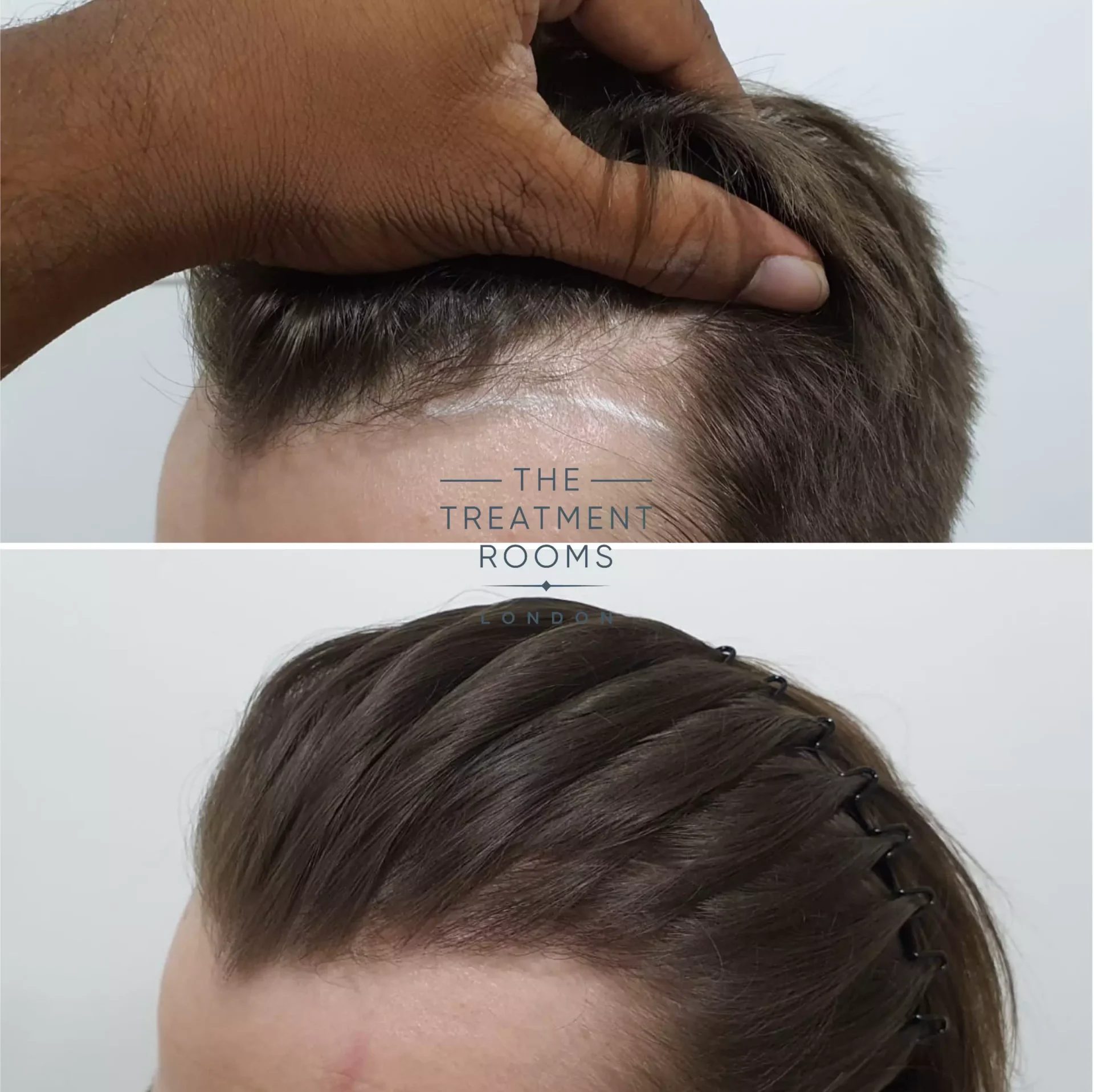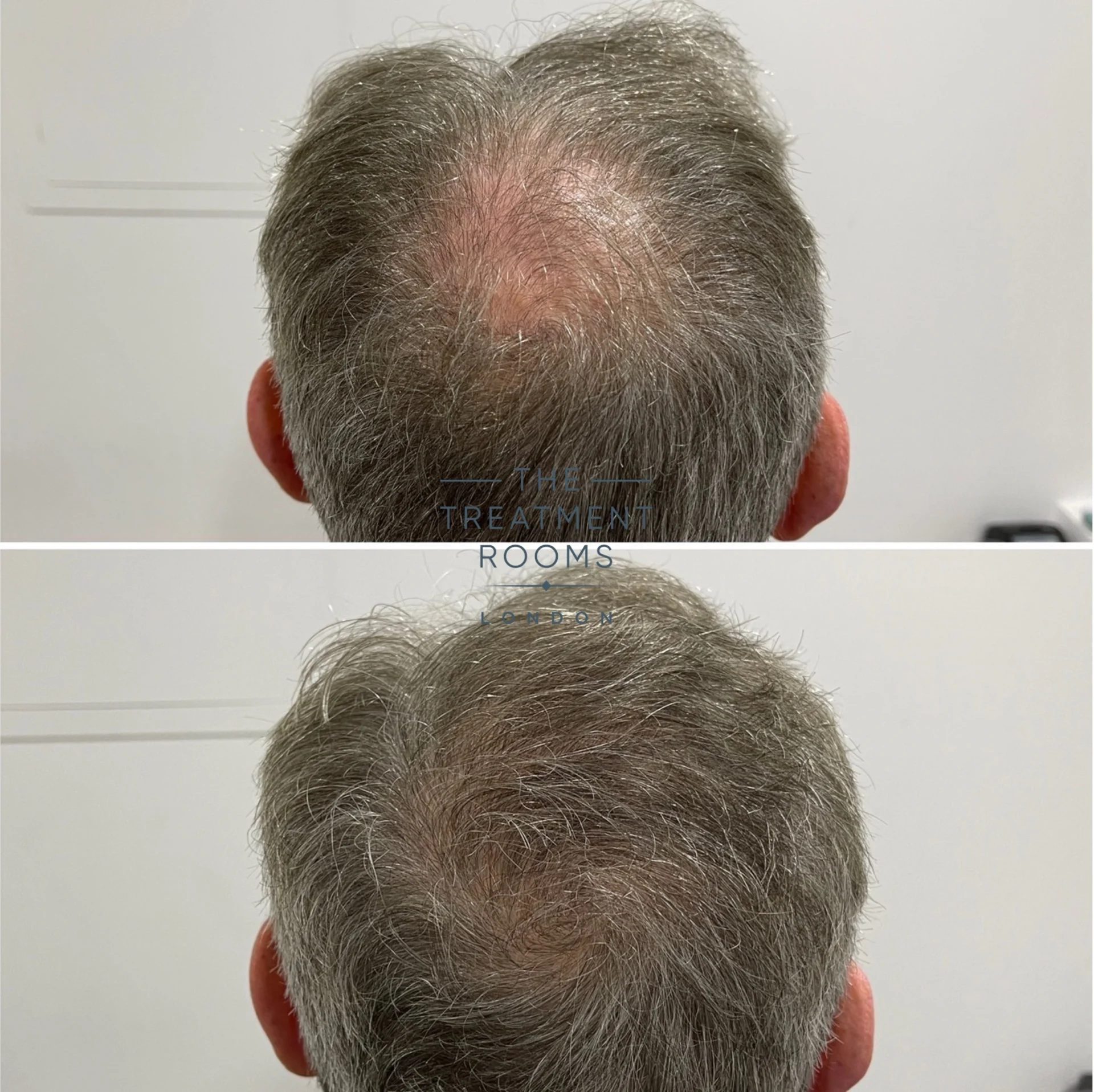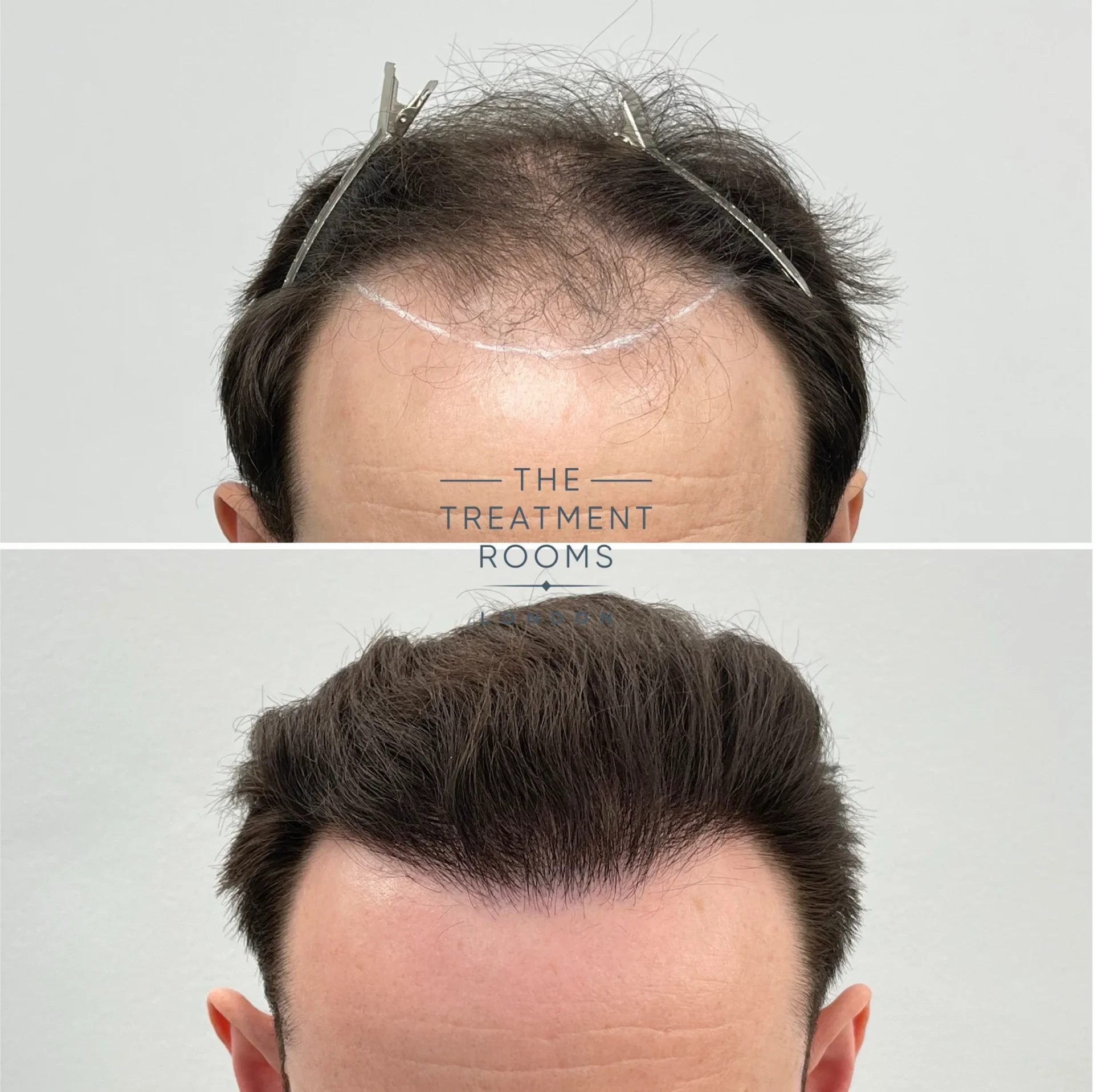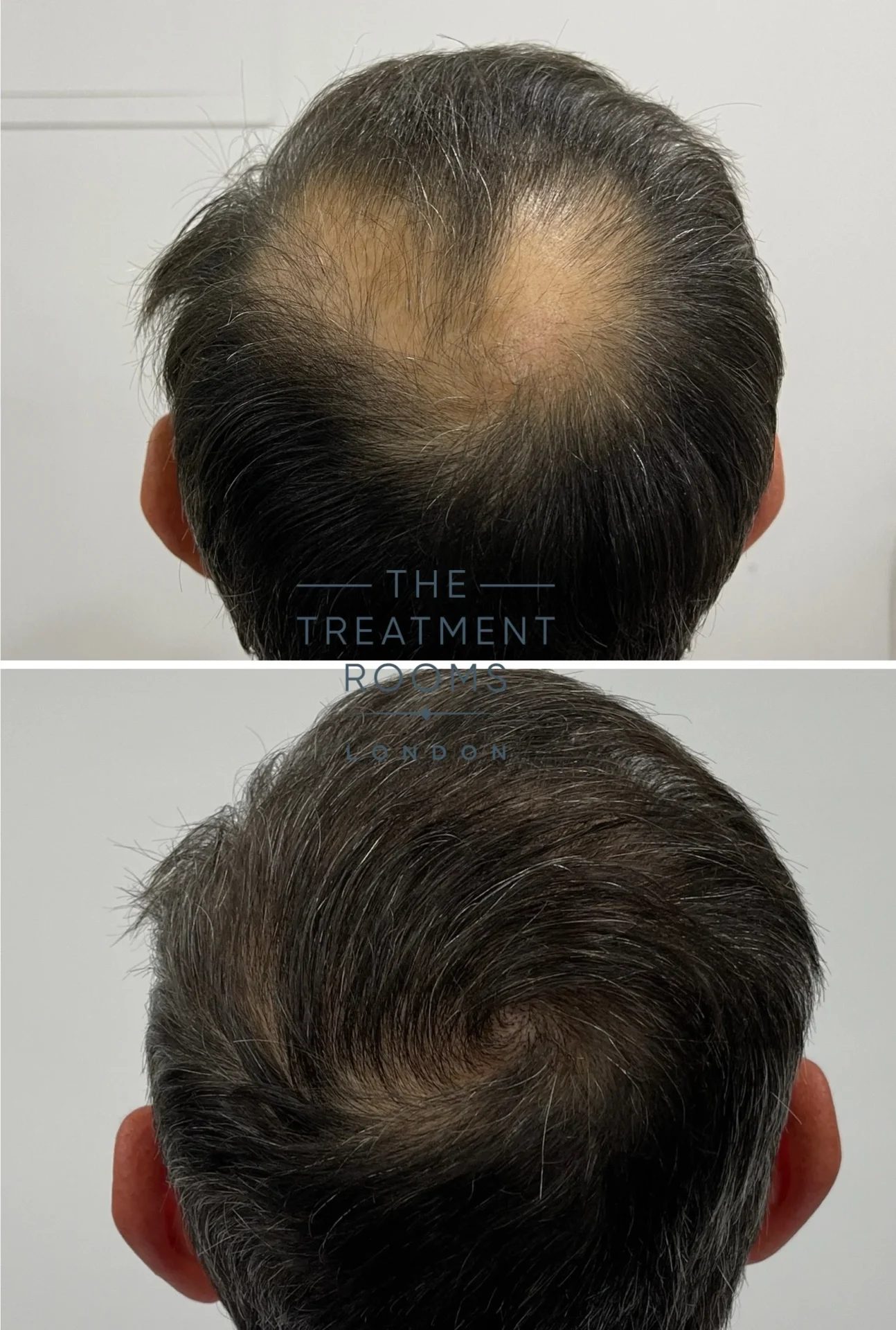An Follicular Unit Excision (FUE) or FUT hair transplant are 2 main procedures available to address hair loss, helping restore hairlines, temples and crowns in male, female and trans patients.
A key question for patients is how many hair grafts are required to achieve their desired result? To answer this question, it’s crucial to first understand what hair transplants involve, by taking a more detailed look at the factors that can impact the calculation.
Calculating how many hair grafts for different areas
Different regions of the scalp require different numbers of hair grafts, depending on the type of look that’s trying to be achieved.
When calculating the number of hair grafts required, it’s important to consider the requirements and guidelines for each of these distinct regions.
To help with this, the Norwood Scale has been designed to analyse the extent of hair loss in patients.
Comprised of seven progressive stages, this scale assesses each patient’s current stage of hair loss, making it easier to make an accurate diagnosis and provide a rough estimate of how many hair grafts will be required.

The Norwood stage that a patient fits into will not only vary depending on where the main areas of hair loss are, but it will also influence the number of hair grafts required3:
- Hairline and temples – to create a more natural-looking hairline towards the front of the head, this will typically require anywhere between 500 and 1,800 hair grafts.
- Mid-scalp – moving further back, somewhere between 500 and 1,500 hair grafts will be needed to address hair loss within the middle of the head.
- Crown – also known as the vertex, restoring hair loss in this area towards the back of the head will usually involve between 1,000 and 2,500 hair grafts.
Generally speaking, achieving a sufficient level of density across the front, mid-scalp and crown regions of the head during an FUE hair transplant will require an average of 4,000- 6000 hair grafts. It’s important to note that not every patient will be able to have such extensive surgery and therefore careful planning in a consultation with a dedicated Surgeon.
| Norwood Scale | Operation Needed? | Location | Number Of Grafts |
|---|---|---|---|
| 1 | No | N/A | 0 |
| 2 | Yes | Temples | 500 – 800 |
| 2a | Yes | Centre | 500 – 800 |
| 3 | Yes | Front and temples | 1000 – 1,700 |
| 3a | Yes | Front and crown | Front: 1000 – 1,700 Crown: 500 – 1000 |
| 4 | Yes | Front and crown | Front: 1,500 – 1,800 Crown: 800 – 1,100 |
| 4a | Yes | Front | 1,700 – 2,500 |
| 5 | Yes | Front and crown | Front: 1,800 – 2,200 Crown: 1000 – 1,500 |
| 5a | Yes | Front and crown | 2,500 – 3,200 |
| 6+ | Yes | Front and crown | Front: 1,800 – 2,500 Crown: 1,500 – 1,700 |
How to calculate your grafts: Hair Transplant Graft Calculator
Here at The Treatment Rooms London, we understand how difficult it can be to determine the number of grafts required for a hair transplant procedure.
That’s why we have created our hair graft calculator – an interactive solution that takes various factors into account, such as your age, gender, hair colour, hair type and hair loss area, to work out the number of grafts required from patient to patient.
Factors that affect how many hair grafts are needed
When calculating the number of hair grafts required for a successful hair transplant, there is no one-size-fits-all solution, unfortunately.
Several factors can influence the overall look, feel and success of a hair transplant, and will need to be individually considered by a specialist before your procedure.
Balding pattern
One of the key factors to consider when calculating the number of hair grafts required is the extent of hair loss and balding pattern.
These can vary drastically from individual to individual, with different balding patterns requiring varying numbers of hair grafts to resolve the issue.
Individuals with minor hair thinning will typically require much fewer grafts than those with advanced baldness or a condition like male pattern baldness, for instance.
Donor area availability
The size, health and availability of hair follicles in the donor area – usually located at either the back or sides of the head – can be a limiting factor for some patients. Patients with a larger donor area, for example, can typically extract more grafts and have more flexibility over what they can achieve from their FUT or FUE hair transplant.
Hair characteristics
The colour, thickness and texture of your hair can all impact the number of hair grafts required for a hair transplant. Having thicker or curlier hair is usually an advantage, providing better coverage but also requiring fewer grafts to achieve a denser look and feel.
Patient goals for their hairline, temples or crown
If a patient wants to achieve a thicker outcome then this will also affect the number of hair grafts required. Conversely, adopting a more conservative, subtle approach when getting a hair transplant will typically require fewer hair grafts than someone deciding to make a more dramatic transformation.
Hair transplants and graft number examples
Below, we will provide examples of levels of hair loss and the graft numbers patients have had when undergoing surgery. We have a full gallery of our hair transplant before and after photos viewable here: hair transplant before and after pictures.
500- 1000 grafts for minimal hair loss

This patient had a small area of recession in his temples. He required 600 grafts for his transplant with his before and after shown above.

This patient had a small area of thinning in his crown. He required 681 grafts for his transplant with his before and after shown above.
1000- 1500 grafts for mild-moderate hair loss

This patient had a mild level of recession in his hairline. He required 1318 grafts for his transplant with his before and after shown above.

This patient had a moderate level of balding in his crown. He required 1380 grafts for his transplant with his before and after shown above.
1500- 2000 grafts for moderate-severe hair loss

This patient had a moderate-severe level of recession in his hairline. He required 1960 grafts for his transplant with his before and after shown above.

This patient had a moderate-severe level of balding in his crown. He required 1877 grafts for his transplant with his before and after shown above.
>2000 grafts for severe hair loss

This patient had a severe level of recession in his hairline. He required 2247 grafts for his transplant with his before and after shown above.
Realistic expectations and desired result
Having a hair transplant can produce potentially life-changing results, with research showing that FUE hair transplants specifically can successfully common conditions like male and female pattern baldness, as well as rarer issues like cleft lip scars, burns and surgical scars4.
However, it’s crucial for patients to maintain realistic expectations both going into it and afterwards as well, by bearing a few key points in mind:
- Hair transplants can achieve natural-looking results – however, FUE and FUT transplants are not designed to give you a full head of hair like you had in your youth. They are there to provide patients with a more natural hairline but not the exact density as before.
- Initial consultations are vital – arranging a consultation with a hair transplant Surgeon is a crucial first step, providing you with an opportunity to calculate the number of grafts you need and set more realistic expectations about what can be achieved. There should not be any sales people involved in making surgical decisions.
- Multiple sessions could be required – hair transplants are not always a ‘one-and-done’ type of procedure. Depending on the extent of hair loss, achieving full coverage may require multiple sessions and might not provide immediate results.
- Correct maintenance is key – FUE and FUT transplants are not designed to stop the progression of hair loss. Therefore, you may need to consider using other non-surgical hair loss treatments, like finasteride or minoxidil, to maintain results over the long term.
- Patience is crucial – the results of an FUE transplant take time and vary from person to person. It can take several months to see the full results, so it’s important to keep patient, utilise your surgeon’s advice and stick to their recommended maintenance plan.
FAQs on hair graft calculations
Here at The Treatment Rooms London, our patients ask us many questions about what’s involved during the FUE hair transplant procedure, especially about the number of hair grafts they are likely to need.
Here are some of the most common questions we get asked.
What is the best way to work out the number of grafts required for an FUE transplant?
Calculating the correct number of grafts required for an FUE hair transplant will vary depending on several factors, including the total area that needs to be covered, the desired hair density and the patient’s specific hair characteristics.
While tools like our hair graft calculator can estimate how many grafts you’ll need, each patient is different. Therefore, arranging a consultation with a hair transplant specialist is the best way to find out how many hair grafts you will need to achieve your specific aims.
What factors can affect the accuracy of my hair graft calculation?
Providing an accurate estimate of the number of hair grafts you need will depend on certain characteristics of your hair, such as its thickness, texture and colour5.
It will also depend on the skill and knowledge level of your surgeon, as well as the overall size and quality of the donor area you have available to use.
Can I achieve the same density as my original hair with an FUE hair transplant?
Achieving the same density as your original hair with an FUE hair transplant can be challenging, as it depends on factors like the availability of donor hair and the extent of baldness.
While an FUE hair transplant can provide excellent results, it often doesn’t replicate the exact density of your original hair. Therefore, it’s important to discuss with your hair transplant Surgeon about what can and can’t be achieved.
How important is the condition of the donor area in calculating the number of hair grafts required?
The health and condition of the donor area condition are critical during graft calculation since they can impact the number of hair follicles available for transplantation.
Put simply, having a healthy donor area with an adequate follicle supply is essential for achieving a successful and natural-looking result from a hair transplant.
Are graft calculations different for men and women?
The number of hair grafts required can differ between men and women due to subtle variations in hair loss patterns and donor areas.
Men typically experience male pattern baldness, for example, which will often require more grafts, whereas women may have different hair loss patterns that will require more specific types of hair graft calculations.
Are there any risks associated with overestimating or underestimating grafts?
Yes, there are several risks associated with both overestimating and underestimating the number of hair grafts required for an FUE hair transplant.
Overestimating can lead to donor depletion, excessive scarring and an unnatural appearance, while underestimating can result in inadequate coverage and lower hair density, which can then impact the overall results6.
This therefore highlights why consulting a hair transplant specialist is so important.
Are there any online tools that can help calculate the number of grafts I need?
Yes, our interactive hair graft calculator has been created for this exact reason. By taking into account your age, gender, hair colour, hair type and hair loss area, we can then work out the number of grafts you will need.
Book a consultation for an accurate graft calculation
Determining the number of hair grafts needed for an FUE hair transplant is a complicated process that will require carefully considering several factors.
While it may be only natural to want to restore your hairline or crown back to its best, it’s equally important to have realistic expectations and understand that achieving a natural appearance is the primary aim of an FUE hair transplant.
Here at The Treatment Rooms London, we have helped thousands of patients achieve successful outcomes with their hair transplant.
Our team of specialists can assess your individual needs, discuss your goals, and provide you with a personalised graft calculation and treatment plan tailored to your exact needs. Simply get in touch with us today to get started.
References
- Collins, K. & Avram, M. (2021). Hair Transplantation and Follicular Unit Extraction. Dermatol Clin. 39(3): 463 – 478. Available at: https://www.sciencedirect.com/science/article/abs/pii/S0733863521000231?via%3Dihub
- Dua, A. & Dua, K. (2010). Follicular Unit Extraction Hair Transplant. J Cutan Aesthet Surg. 3(2): 76 – 81. Available at: https://www.ncbi.nlm.nih.gov/pmc/articles/PMC2956961/
- Chouhan, K., Roga, G., Kumar, A. & Gupta, J. (2019) Approach to Hair Transplantation in Advanced Grade Baldness by Follicular Unit Extraction: A Retrospective Analysis of 820 Cases. J Cutan Aesthet Surg. 12(4): 215 – 222. Available at: https://www.ncbi.nlm.nih.gov/pmc/articles/PMC6967160/
- Sharma, R. & Ranjan, A. (2019). Follicular Unit Extraction (FUE) Hair Transplant: Curves Ahead. J Maxillofac Oral Surg. 18(4): 509 – 517. Available at: https://pubmed.ncbi.nlm.nih.gov/31624428/
- Zito, P. & Raggio, B. Hair Transplantation [Updated 2023 Feb 14]. In: StatPearls [Internet]. Treasure Island (FL): StatPearls Publishing; 2023. Available from: https://www.ncbi.nlm.nih.gov/books/NBK547740/
- Kerure, A. & Patwardhan, N. (2018) Complications in Hair Transplantation. J Cutan Aesthet Surg. 11(4): 182 – 189. Available at: https://www.ncbi.nlm.nih.gov/pmc/articles/PMC6371733/
Share:
Authored by
Reviewed by
Book a Consultation
Related Blogs
When Can You Safely Wear a Beanie After a Hair Transplant?
July 3, 2025
Quick Summary Cap Recommendations: Light, breathable caps, such as snapbacks or trucker hats, are advisable if you need…
Castor Oil (Ricino Oil) for Hair Growth: Benefits, Uses & How to Apply for Maximum Results
June 26, 2025
Castor oil, also known as Ricino oil, is extracted from the Castor bean plant (Ricinus communis). During…
What is a Hair Transplant? How it Works, Success Rate & What to Expect
June 23, 2025
Hair transplantation is a cosmetic surgical procedure that restores hair by moving healthy follicles from one part…
John Cena Hair Transplant
May 14, 2025
John Cena, a common household name, is a figure who has effortlessly straddled the worlds of professional…
Kyle Walker Hair Transplant: Before, After, and His New Hairline
May 12, 2025
Kyle Walker is known for his defensive skills at Tottenham Hotspur, Manchester City, and in the England…
Celebrity Hair Transplants: Full Before and After Analysis
May 8, 2025
Elon Musk Hair Transplant Elon Musk, the billionaire behind Tesla and SpaceX, is well-known for his innovations…
Lewis Hamilton Hair Transplant: Before, After, and His New Hairline
May 7, 2025
As a top-class racing driver, Hamilton is used to wearing a race helmet. While this does protect…
James Nesbitt Hair Transplant: Before, After, and His New Hairline
May 6, 2025
James Nesbitt, the Northern Irish actor famed for his role as Adam Williams in the British comedy-drama…
Cristiano Ronaldo’s Hair and Hairline
May 2, 2025
Cristiano Ronaldo, the football icon, is celebrated as much for his on-field brilliance as his impeccably groomed…











